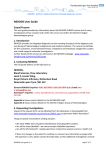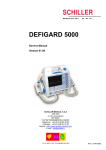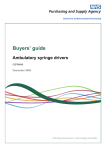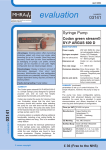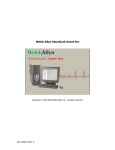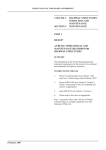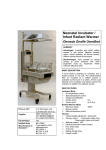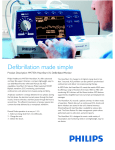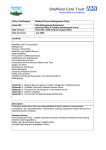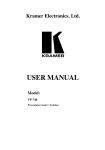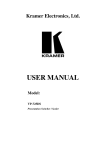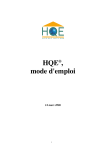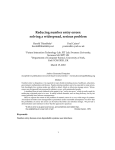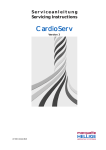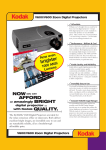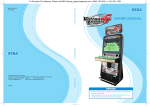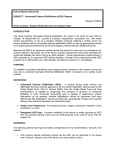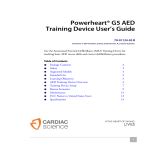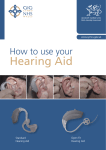Download Welch Allyn AED 20
Transcript
March 2004 MHRA 04018 Defibrillator Welch Allyn AED 20 best choice ● best practice www.mhra.gov.uk nww.medical-devices.nhs.uk Summary Information Defibrillator Welch Allyn AED 20 MAIN FEATURES Power Supply rechargeable NiMH or non-rechargeable lithium battery Claimed Performance Characteristics l charging time 360 J < 8 seconds l deliverable energy CONTENTS Page Description User Assessment Technical Evaluation Manufacturer’s Comments Results Table Product Data Appendix (& MHRA alert on biphasic shock levels—all manufacturers) l discharge mode 2 4 6 10 11 13 Facilities 16 SUMMARY Advantages: lightweight; compact; good data logging capabilities; generally easy to use; good instructions manual. 150, 200, 300, 360 J in semi-automatic mode 2–360 J manual mode biphasic or monophasic l ecg display optional l ecg recording to printer or computer l data handling 1 MB internal memory & 4, 8 or 16 MB PCMCIA l shock advisory l log review yes optional and timer. More advanced models display the ECG trace—this facility is enabled or disabled from a supervisor menu that is password protected. The shock protocol is also configurable from this menu. The on-screen instructions augment voice prompts when the unit is in AED mode. Disadvantages: reliability of rechargeable batteries not as good as non-rechargeable lithium batteries. Overall: basic model is a good first responder defibrillator. Fully featured model is versatile. Training required before use. Well liked by surveyed users. Power is from either a rechargeable NiMH battery (re-charged externally) or a non-rechargeable lithium battery. The battery forms the carrying handle when inserted into the defibrillator—the idea being that the unit cannot be picked up and carried to an incident if it is not present. BRIEF DESCRIPTION The Welch Allyn AED 20 is a lightweight semiautomatic defibrillator. In its various versions, it is suitable for use both by first responders and users trained in Advanced Life Suport (ALS). The most advanced version allows manual operation in which analysis of the ECG and shock delivery is left entirely to the user. Shocks are administered by single-use multifunction electrode pads: there is no paddle option. The output shock has a biphasic waveform although the unit can be purchased with a conventional monophasic output if required. The AED 20 has a large monochrome LCD panel with optional backlight. This displays information such as user prompts, shock counter, battery status Price (ex VAT) from £1995 (list price) Manufacturer Welch Allyn CE Marking? MD Directive, CE0197 Notified Body TÜV Rheinland Product Safety GmbH Manufactured to EN 60601-1 & other relevant Standard? standards 1 MHRA evaluation 04018, March 2004 Description Welch Allyn AED 20 DESCRIPTION General Elapsed time The Welch Allyn AED 20 (formerly the MRL LifeQuest AED) is a lightweight compact defibrillator with a monochrome LCD screen that displays the patient data and optionally the ECG waveform. There are three main versions available and a range of setup configurations: thus it is designed for a wide range of personnel trained in Basic Life Support (BLS) i.e. from first responders to personnel trained in Advanced Life Support (ALS). Shocks counter ECG trace window Menu selection window Energy bar Prompts window Icons window The basic model is semi-automatic where the user follows a three-step protocol with voice and screen prompts. No ECG trace is displayed. The intermediate model displays ECG and provides a re-useable ECG lead set to enable continuous monitoring of patients without connecting the defibrillator pads. The most advanced model additionally provides full manual control of the defibrillator. This facility can be made accessible only by entering a pass-code. Defib window Menu bar Figure 1 Screen Layout Prompts are issued to check the pulse, airways and carry out CPR if necessary. If the shock is unsuccessful, the process repeats to provide a total of three shocks at charge levels determined by the pre-set (though adjustable) charge protocol. Controls and display Time stamped data logging facilities (including audio recording if required) are provided. The data is stored internally with additional capacity on interchangeable PCMCIA memory cards. (Note: these cards are computer-readable.) As well as the on/off and shock controls, there are four ‘soft keys’ below the screen. These are not marked or highlighted in any way but have a raised surface and are adjacent to indents on the screen bezel to help locate them by touch. The soft keys are shown on figure 2. The AED 20 in its basic form delivers biphasic shocks although the unit can be purchased with a conventional monophasic output. They are used in conjunction with labels displayed on the screen menu bar and a menu selection area on the centre left. The screen itself is 14.1 cm (diagonal) monochrome divided into several areas or ‘windows’ as shown in figure 1. An MHRA device alert on biphasic shock levels (all manufacturers) is included in the appendix. Defibrillation in semi-automatic mode The patient’s ECG is displayed in the upper area above the prompts window in which text messages show defibrillator status or guide users through a defibrillation procedure. Other relevant information is also displayed: the patient’s heart- This is a three-stage process. Switching on the defibrillator via a large green button (stage 1) invokes a short self-test followed by a voice prompt “Apply pads to patient’s bare chest —attach defib pads to cable”. When this is done it prompts (stage 2) “Analysing heart rhythm—do not touch the patient”. Screen messages are simultaneously displayed in the prompts window (see screen layout in figure 1). After a few seconds of analysis, if a shockable rhythm is detected the defibrillator announces that a shock is advised and to “Stand clear!” while it charges to the configured energy level and simultaneously emits a staccato warning tone. When ready, a large red button lights up (stage 3) with prompts to deliver the shock: “Press the red button now!”. Once the shock is delivered and announced, analysis of the heart rhythm recommences. MHRA evaluation 04018, March 2004 Heart rate Soft keys Figure 2 2 Description Welch Allyn AED20 rate, the energy level of the most recently delivered shock and the number of shocks administered since powering up the device. Operating status information is provided by displayed icons that act as pictorial indicators of battery level, remaining memory (used for datalogging), speaker volume, screen contrast etc. Manual mode (Option) When switched on, the unit defaults to automated mode but is changed by pressing the ‘manual’ soft-key and entering a numerical pass-code. Figure 3 In manual mode, rhythm analysis and voice prompts are not available. The user is free to adjust the charging level over the range 2–360 J and charge or disarm the defibrillator as he/she sees fit. The shock is delivered as before by means of the red button. Electrode monitoring This optional facility is provided to allow extended monitoring of patients who are not in immediate need of defibrillation and so don’t yet have defibrillator pads applied. The two-electrode ECG monitoring cable provided with this option is connected to the same socket as used for the defibrillator pads. Its presence is recognised and the unit can now be used for ‘monitoring only’ during which shock delivery is inhibited. Rhythm analysis can be initiated by the user from a soft key (if in AED mode) and if a shockable rhythm is detected, a voice and text prompt announces “Change to pads” before a shock can be given. Once the defibrillator has been switched off, it reverts to AED mode at next use. EMS mode This mode is provided on all models and is designed for use by Emergency Medical Services (e.g. ambulance paramedic staff). This is most suitable when continuous AED mode analysis is required while transporting a patient or carrying out some other procedure. Supervisor menu A passcode protected supervisor menu allows fundamental configuration changes such as EMS mode enable/disable, altering the charge protocol, accessing memory card facilities, audio recording enable/disable, performing software upgrades and selecting an alternative language (figure 4). Its status is enabled/disabled from the menu softkey (the exact procedure is model-dependent) and requires a passcode to do so. The defibrillator’s EMS status remains unchanged at next use. At switch-on, the unit behaves as in automatic mode i.e. the self-check followed by voice/screen prompts to attach electrodes. Full heart rhythm analysis does not take place at this stage: the screen prompt (figure 2) is “Monitoring ECG, press to analyse” but without a voice prompt (‘voice off’ mode). Background analysis continues to take place and if a shockable arrhythmia is detected, the unit returns to ‘voice on’ mode with “Check Patient” and a screen prompt shown in figure 3. Defibrillation electrodes Shocks are delivered via single use, hands-free electrodes, there being no paddle option available Once ‘analyze’ has been pressed, the unit proceeds through analysis, charging and shock (assuming one was deemed necessary), advice to check the patient etc, in the same way as semi-automatic mode. If the patient is successfully defibrillated, no further voice prompts occur and background monitoring of ECG resumes as before, confirmed by the screen prompt of figure 2. Figure 4 3 MHRA evaluation 04018, March 2004 Description Welch Allyn AED20 for the AED 20. Both pads are of the same hexagonal shape and are not labelled as sternum and apex, although they have white and blue leads respectively. To ensure correct placement, they are imprinted with diagrams showing their ideal positions. The pad set’s twin leads (1 m long) are terminated with a plastic non-reversible connector that plugs into the defibrillator via a small moulded adapter. The connector is held in place by a built-in latch. Figure 5 System ready indicator conditions Power supply options There is a separate LCD 'system ready indicator' located on the lower left corner of the AED 20. Without having to switch the unit on, it shows whether or not the battery and defibrillator are fit for immediate use. The indicator has three states (see figure 5): ‘ready’—the battery is properly installed and the unit is ready for use; ‘do not use’ —the battery may not be properly installed, the charge is too low or the unit requires attention; ’flashing’—the battery is low and requires changing or the unit requires servicing. The AED 20 is powered by a 12 V battery which slots into the defibrillator case where it locks into position and forms the device’s carrying handle. There are two battery types: a rechargeable 12 V with a capacity of 2.1 Ah or a non-rechargeable 5.2 Ah lithium battery that has a claimed standby life of five years (while installed in the defibrillator) following a claimed storage life of up to five years i.e. 10 years in total The NiMH batteries are charged using a separate unit (see below) taking 1.5 to 2 hours to complete. The charger also conditions batteries to maintain them in their optimal state for as long as possible. The manufacturer recommends renewal of NiMH batteries every 2 years. Data logging The AED 20 stores event information including patient status, ECG traces, audio (if enabled) and treatment summary in an internal log or on an optional removable PCMCIA memory card. The 1 MB of internal memory stores 100 4-second ECG samples or 300 time stamped events. A new NiMH battery is specified to provide three hours continuous monitoring from a single charge or 80 shocks at 360 J; a new lithium battery is specified for 6 hours or 200 shocks. The 4, 8 and 16 MB memory cards store respectively 90 min of ECG or 40 min of ECG with audio, 3 hours of ECG or 80 min ECG with audio and 6 hours ECG or 2.5 hours ECG with audio. An on-screen battery 'fuel gauge' shows the remaining power and whether the battery is rechargeable or non-rechargeable. Stored information can be transferred to a printer or computer for subsequent review using 'SmartLink Direct' software via the built-in serial data port and an appropriate cable (or Welch Allyn communication kit). Alternatively, data recorded to a PCMCIA flash-memory card can be reviewed and printed using a card-reader and optional 'SmartView' software. USER ASSESSMENT User opinion was obtained from a survey of existing users in six NHS locations. There were 20 respondents representing nursing staff, resuscitation officers, ambulance service paramedics and EBME staff. Users were asked to complete questionnaires, grading their answers on a five-point scale. The principal results were averaged (see graph) together with a breakdown of how many users awarded each score. Each average rating also has an 'consensus bar’ that helps to show the NiMH battery in charging unit MHRA evaluation 04018, March 2004 4 User Assessment Welch Allyn AED 20 User Survey Results Top Graph: Average Rating with Consensus Bars Lower Graph: Distribution of Ratings Ex. Good Sat. Poor Very Poor Poor Satisfactory level of agreement among users (short bars imply good consensus but long ones imply less). Nearly all users had either extensive or moderate experience with defibrillator equipment, the majority having used the AED 20 for 2–3 years. One was a trainee who answered fewer of the questions (this is why the maximum response above is 19 and not 20). Twelve had used the defibrillator in an emergency. Good Manufacturers training Product support User manual ECG leads Ease of connection Electrode pads Overall portability Weight Size Data storage Event recorder Battery charger Battery performance Battery replacement User configuration Screen size Use in manual mode Visual messages Audible messages Use in semi-auto mode Ease of setting up 19 18 17 16 15 14 13 12 11 10 9 8 7 6 5 4 3 2 1 0 Suitability Number of Responses V.Poor Excellent departments. The most commonly stated opinions were either ‘good’ or ‘excellent’; our conclusion is that the defibrillator worked well and users had relatively minor concerns with performance. When the equipment was originally installed, no serious initial difficulties occurred beyond what would be considered normal with new equipment. Data Storage One of the users (a resuscitation officer) said that having initially tried a 4 MB memory card to store patient data, this size proved to be too small. The card was upgraded to 16 MB and this size was found satisfactory. From the consistently favourable responses to all of our performance-related questions, it was clear that all the surveyed users thought the AED 20 was satisfactory or better for use in their 5 MHRA evaluation 04018, March 2004 Technical Assessment Welch Allyn AED 20 Batteries All but one of the surveyed locations used the non-rechargeable lithium batteries. The hospital location that used rechargeable batteries had experienced difficulty with them. Ward staff said that the batteries would lose their charge with the passage of time and that it could be difficult visually gauging the remaining charge. A fault that affected four of their AED 20s may have contributed to the difficulty (see ‘reliability’ below). Their solution was to switch to using the nonrechargeable batteries which have a guaranteed shelf-life and capacity. One user said, "we now use lithium batteries which are excellent". remainder had undergone formal training by their employer. Only one of the users was dissatisfied with the manufacturers training, he said that he thought it was "very basic". General To summarise, the majority of our user sample were very happy with the AED 20. Typical comments were: "An excellent, easy to use defibrillator with a comprehensive recognition algorithm and excellent self-adhesive electrodes." "Very portable and easy to use, I especially like the audible messages." Display Nearly all of the surveyed users thought that the screen size and visibility was at least satisfactory, 70% said either ‘good’ or ‘excellent’. However, one user thought that the "screen could be bigger" and another rated it as poor but gave no reason. "A satisfactory unit that is reasonably simple to use with clear display and functions." TECHNICAL EVALUATION Our main findings are discussed in this section. A summary, with numerical and other data is given in the Results Table. The evaluated AED 20 sample was an earlier MRL LifeQuest AED model 970200; the installed software was version V: 05.07.00UK. Electrode Pads The design and connection of the electrode pads were also generally liked. However, one user said that they had experienced problems when trying to attach pads to a small and frail patient and added that the "connections didn't always appear secure". Safety The defibrillator carried CE marking in respect of the Medical Devices Directive (MDD) of the European Community. Documentation showed it to be a class IIb device manufactured by Medical Research Laboratories Inc., Illinois, USA (a Welch Allyn owned company); the assessment route was via Annex II of the Medical Device Directive 93/42/EEC; the notified body was TÜV Rheinland Product Safety GmbH, Germany, Identification No. 0197. Compliance with EN 60601-1 and other relevant standards was claimed. Portability Users rated the defibrillator’s overall portability very highly with the majority giving it a score of excellent. Reliability Most of the users (81%) had no reliability issues to report, however one location that used rechargeable batteries had experienced four battery connection failures and one onscreen battery indicator failure (see ‘Batteries’ above). They said that the repairs took a long time, although loan units were supplied. Using the AED 20 An ambulance service user said that he thought the machine was unreliable as it had failed to shock under emergency conditions although this had apparently been due to a poor pad contact (pads too large for small frail patient—see electrode pad comments above). Semi automatic operation As a semi-automatic defibrillator we thought the AED 20 would be straightforward to use by trained first responders. —user opinion confirmed this was the case. User prompts, both audible and visual were clear and unambiguous, requiring the user only to press the shock button after it had illuminated if a shock was deemed necessary. In the case of a defibrillator with the manual option, the unit defaulted to semiautomatic mode at switch-on, i.e. it behaved identically to the basic AED 20 option. We asked users if they were responsible for the decision to purchase the device and if so, why they chose the AED 20. Several users commented with answers such as, "easy to use and portable with a limited amount of preparation needed", "price was competitive, the unit appeared robust and came with a 7-year warranty" and "I wasn't responsible this time but in the future I would be very happy to purchase for both community and hospital based use". The process was slightly less straightforward if the ECG cables were connected instead of a pad set (manual and intermediate models), when the unit was ‘monitoring only’. Even so, it was easy to initiate analysis of the patient’s waveform before applying defibrillation pads, thus activating semi- Training The manufacturer had given training to eleven of the twenty surveyed users; the MHRA evaluation 04018, March 2004 6 Welch Allyn AED20 Technical Assessment Using defibrillators—what are we assessing? AED/manual defibrillators should ideally: l Be simple to use by first responders with no risk of confusion by controls intended for manual operation. l Be straightforward to use for emergency defibrillation in manual mode by medical staff not already familiar with the device. As well as assessing the above, we check to see if any mode of operation can inhibit emergency defibrillation or if the software is susceptible to malfunction caused by random and multiple use of controls. We also check how long it takes to deliver 200 J from power-up. Figure 6 enter a passcode (in appropriate clinical settings) thus preventing or delaying a user unfamiliar with the AED 20 from carrying out an immediate defibrillation. automatic operation. EMS Mode Unlike manual mode, if EMS mode was activated (via the passcode protected supervisor menu) it remained selected at next power-on. Thus any AED 20 defibrillator set up in EMS mode will not work as expected by a first responder trained in BLS. Even someone trained in ALS who had never seen the equipment before could well hesitate before spotting that it was necessary to press a soft-key to initiate rhythm analysis. From the soft keys, simple functions (e.g. speaker volume) were directly available and also access to the user menu functions (see left hand section—figure 4). The soft-keys were much less prominent than the on/off/shock buttons so as not to provide a distraction to first responders. Manual operation The AED 20 was primarily a semi-automatic device and manual use requires that option to be installed. Since at power-on the unit defaulted to semi-automatic mode, it was first necessary to operate the manual mode soft-key. This key was available as soon as the self-test began, so could be selected almost immediately if the passcode was set at 000 (and known to be so). Once self-test was complete, the unit switched to manual mode within which its default soft-key menu provided immediate access to energy level selection and charge function (figure 6). Defibrillator Performance The manufacturer stated that delivered shocks were in the form of a biphasic truncated exponential waveform. The waveform of a 360 J discharge into a 50 ohm load is shown in Figure 7: the voltage peaked at 1290 V and 830 V in the positive and negative phases respectively with a total shock duration of 21 ms. In manual mode, delivered energy into a 50 ohm load was measured and found to be in good agreement with the energy delivered display. In manual mode this message remained for approximately 10 seconds. Once the unit had charged, the shock was delivered via the large red button. Using a fully charged battery, a typical time from power-up to having 200 J ready to discharge was approximately 20 seconds. This period included the power-up self test and the time required (by an experienced user) to put the device into manual mode with the passcode set to 000. Similarly, the time from power-up to completion of a 200–200–360 J discharge sequence was approximately 36 seconds. Tests were carried out to see if normal operation of the defibrillator could be upset by a combination of keystrokes or a random series of keystrokes. None was found except if this activity occurred during the power-on self-test. Since one of the self-tests was to check the integrity of the controls, unusual key presses at this time could, not unexpectedly, cause the test to fail. This was announced by four warning beeps, a screen message and the ‘do not use’ symbol was illuminated. Correct operation was restored by switching the power off and then on again. Entering the passcode required multiple key presses to increment through each of three digits and could add a few seconds to the process. Miskeying, i.e. overshooting a digit added significant delay as there was no decrement facility. There was no facility to disable the requirement to 7 MHRA evaluation 04018, March 2004 Technical Assessment Welch Allyn AED 20 Mains frequency noise rejection was good, there being no trace deflection from a 20 Vrms, 50 Hz common mode input. Common mode rejection in balanced and unbalanced conditions also met specification as did low frequency noise rejection (0.5–25 Hz). 1500 Peak Voltage (+.ve) = 1290 V Voltage (V) 1000 500 Pacing pulses of 5 mV and 1 ms duration were applied at a rate of 100 per minute to the ECG electrodes. Such pacing pulses should be ignored by a heart-rate meter—in this case however, they were counted as if they were ECG complexes. Energy Delivered = 352.3 J 0 0 1 2 3 4 5 6 7 8 9 10 11 12 13 14 15 16 17 18 19 20 21 22 23 -500 -1000 Peak Voltage (-.ve) = 830 V Adjustment of the ECG sensitivity (to give an adequate sized trace) was automatic and its current setting was shown at the top-left of the ECG trace area. There were four settings of x 0.25, x 0.5, x 1 and x 2, which corresponded to measured sensitivities of 2.5, 5, 10 and 20 mm/mV respectively—this information was not in the published specification. The trace speed had undoubtedly been chosen (22.5 mm/s) to give a five-second display—we measured no discernible error. Time (ms) Figure 7 ECG monitor The cable supplied with the ECG upgrade option was a two-electrode cable which attached to the defibrillator in place of the pads via a keyed connector. The two-electrode snap-on connectors were labelled R (red/right arm) and F (green/left leg) in accordance with IEC colour 1 convention to give a fixed lead II configuration. Once connected, the defibrillator displayed 'MONITOR ONLY' since it could not deliver shocks via the monitoring cable. Thus if the charge key was pressed in manual mode, a tone sounded with a warning, 'CHANGE TO PADS'. In AED mode a detached electrode led immediately to a three-tone alarm and an 'ATTACH PADS' message. The voice prompt stated 'Apply pads to patient's bare chest, connect defib pads to cable'. Alarms and voice prompts continued every 15 seconds thereafter. In manual mode there was a similar response but without the voice prompt. Physiological effects caused by the application of electrodes to a patient can create DC offsets that might interfere with monitoring. Thus DC offsets were applied to the electrodes until cut-off of ECG monitoring occurred. This was signalled by a message, 'ATTACH PADS' and warning tones when offsets of +2.48V and -2.55V had been applied. ECG trace recovery from the applied offsets (after their removal) was less than one second—a good result. Test facilities A self-test occurred each time the unit was switched on. Whilst underway, various messages were displayed: 'SELF TEST INITIATED', 'SELF TEST ACTIVE' and 'SELF TEST PASSED (FAILED)'. Tests comprised of checks on the control buttons, battery, main processor, internal circuitry, defibrillator, ECG tracing, manual mode and external memory card depending on the options present and the unit's configuration. Over a one-hour period, no drift of the baseline occurred. The trace position and intensity were non-adjustable but there were nine discrete settings of display contrast, none of which caused the trace to entirely disappear. The specified frequency response was 0.5–40 Hz, though given the pixel size of the LCD panel, only frequencies up to 31.6 Hz were theoretically reproduceable. The measured frequency response was approximately 1–25Hz. The user manual contained information and checklists for staff to perform daily, weekly and monthly checks. Two checklists were provided, one for frequent use (rechargeable battery) and one for infrequent use (non-rechargeable battery). Batteries Using a set of thermocouples, the temperatures achieved by a fully charged NiMH battery were logged while a series of 360 J shocks were made into a 50 ohm load at a rate of three shocks in 90 seconds with a 60 second rest between groups of three shocks. After 15 shocks, the temperature rose by 4.6°C. The test concluded when no further discharges could be The dynamic range of the display satisfactorily met the criterion of correctly displaying 5 ms pulses at different repetition rates. Similarly, a linearity test showed that the size or shape of a complex was unaffected by its position on the screen. MHRA evaluation 04018, March 2004 8 Welch Allyn AED20 Technical Assessment a maximum temperature of 42.4°C, a rise of 19.6°C above ambient. Low battery alarms and messages occurred after the 188th shock. Battery testing The following is a summary of the manufacturer’s battery capacity test. When users carry out this procedure it also helps them to estimate the operating time remaining by observation of the battery icon. It was important for users to check batteries monthly to determine their capacity for monitoring. Defibrillation pads The supplied pads were Cardiotronics Systems R2 model 3200-01 adult radiolucent multifunction conductive adhesive electrodes. They were manufactured by Ballard Medical Products and packaged as KimberlyClark R2 model 3200-1715. The packaging had clear application instructions, CE marking and diagrams showing acceptable pad positioning. The expiry date was clear and the storage temperature range was shown (5 to 35°C). 1 Connect a patient simulator or test load to the defibrillator (without either the unit would autoshutdown after 10 minutes), note the start time; 2 Verify operation every 30 minutes or less; 3 Note when the battery runs out, the overall time gives an indication of its capacity; typically it should provide at least 3 hours of monitoring; The pad connector plugged directly into a rightangled adapter-socket on the front of the defibrillator. However, the plug had to be oriented correctly to plug into the socket and there was no visual aid to help the user do this quickly (e.g colour coding the adapter to match the plug). 4 If operating time is less than 3 hours, recharge the battery and repeat the test, if the operating time remains at less than 3 hours remove the battery from service; The body of the adapter seemed robust but the plastic lining around the pins looked a little less durable. After many years use it could be susceptible to wear and subsequently reduce the reliability of connection with the pads electrodes. Fortunately, the adapter socket was replaceable thus with effective servicing there should be no problem. The adapter also obscured the ‘Type BF’ symbol engraved adjacent to the input (required by EN 60601-1) but this has been corrected on recent models. 5 Recharge batteries fully before returning to use. Those charged in high ambient temperatures (>30°C) or which normally encounter more than one daily charge/discharge cycle to be reconditioned once every 30 days. Users were warned not to exceed the stated battery life of 24 months. made and the defibrillator shut down. The maximum temperature achieved was 41.5°C, a rise of 16.8°C above ambient. The DC offset voltage produced across the pads following three maximum energy (360J) discharges was measured at 5, 10, 30, 45 and 60 seconds following the last discharge. The voltage dropped from 91.1mV at 5 seconds to 52.2mV after 60 seconds. This was well within the capabilities of the monitor (see page 7). After the 56th shock, alarm tones were sounded, the on-screen battery gauge displayed 'low' and the system-ready indicator began to flash. In total, 75 shocks of 360 J were delivered. At this stage, with the defibrillator now incapable of further operation, it shut down to prevent deep discharge of the battery. The system-ready indicator continued to flash, thus showing that the battery needed replacing. The pad impedance was measured every five discharges over a 30 discharge period; maximum energy (360 J) shocks were delivered at 30 second intervals into a 50 ohm load. At room temperature the pad impedance measured approximately 0.25 ohm, rising to 0.28 ohm after the 30th shock. A theoretical worst case scenario is when a battery is removed from the charger at the point of maximum charging temperature, inserted into the defibrillator and discharged by delivering 15 maximum energy shocks. However the calculated temperature for these batteries was only 39.4°C. Unopened packets of pads were conditioned according to the MHRA test protocol at a constant -2°C and 40°C respectively for one week in a temperature controlled environment. No change in physical appearance or performance resulted. A fully depleted battery was again monitored for temperature during the charging process. After 79 minutes the maximum temperature achieved was 34.8°C, a rise of 10.8°C above ambient . Rhythm analysis The ECG rhythm analysis algorithm was designed to recognise as shockable, any ventricular fibrillation (VF) waveforms with amplitudes greater than 150 µV We also tested the non-rechargeable lithium battery, we found that it was capable of delivering 201 shocks of 360J into the 50 ohm load reaching 9 MHRA evaluation 04018, March 2004 Technical Assessment and wide complex ventricular tachycardia (VT) at a rate greater than 160 bpm. The MHRA ECG arrhythmia database The database consists of 258 ECG arrhythmia waveforms that were extracted from real patients’ ECG recordings. They were analysed by a group of cardiologists who classified them according to whether or not a patient exhibiting such a waveform should be administered a shock. The majority of the ‘shockable’ recordings comprise ventricular fibrillation or ventricular tachycardia. The others are a mixture of other arrhythmias including a number caused by movement artefacts. Non-shockable rhythms were various sinus rhythms including supraventricular tachycardia, atrial fibrillation, atrial flutter, sinus rhythm with PVC's, asystole, pacemaker rhythms and ventricular tachycardia at a rate less than 160 bpm and/or narrow complexes. The unit was tested against the MHRA ECG arrhythmia database. The results for sensitivity to VF and VT were good with sensitivity to VF better than 98% and sensitivity to VF and VT greater than 180 bpm better than 90%. The average analysis time to reach a true positive was approximately 15 seconds. The specificity was also good with results better than 88%, the average time to reach a no-shock decision for a true negative was approximately 19 seconds (refer to the Results Table). Each waveform is presented three times to the defibrillator under test. MANUFACTURER’S COMMENTS The report was sent to the manufacturer via the UK supplier. In their reply no specific comments were made. The time from power-up initiation to the delivery of a 200 J shock on presentation of a definitive shockable rhythm was approximately 33 seconds. The time from power-up to completion of a three shock sequence (200–200–360 J) was similarly measured at approximately 69 seconds. The minimum amplitude of VF, which the defibrillator would interpret as a shockable rhythm was determined by applying a 5 Hz sinusoidal wave, the resulting amplitude was 0.094 mV. Serviceability and manuals Since there was wide use of surface-mount-technology (SMT) circuit boards, the service policy was for replacement of faulty components to assembly level, rather than repair to component level. Replacement of assemblies would not be a trivial task due to the quantity of sealing compound used on several of the circuit boards. However, the service manual contained all the necessary information to do this, as well as a good troubleshooting guide, dismantling instructions and performance test procedures. It was supplied simply as a printed PDF, nevertheless the use of illustrations was excellent and overall it was quite satisfactory. The user manual was good. It too had excellent diagrams and was produced to a satisfactory quality. Nearly all of the expected information was present, but some was missing because the manual supplied with the equipment was for an earlier release of the AED 20. All of the information was included in the current version. Reliability The defibrillator operated without fault during the evaluation periods. MHRA evaluation 04018, March 2004 Welch Allyn AED 20 10 Results Table Welch Allyn AED 20 RESULTS TABLE pass Leakage Currents Performance of defibrillator l delivered energy in to 50 ohm load1 pass manual mode AED mode l time from switch on to 200 J ready 20 seconds 33 seconds2 l time to completion of 200/200/360 J sequence 36 seconds 69 seconds2 l inhibition of manual defibrillation pass-code l susceptibility to abnormal pass; self-test reports fail if key is depressed while test is in progress (key status is part of test) operations3 l susceptibility to interference none Performance of shock advisory system best (%) worst (%) l sensitivity to VF 100.0 98.3 l sensitivity to VF + VT > 150 bpm 84.4 78.9 l sensitivity to VF + VT > 180 bpm 96.0 90.7 l specificity (VF + VT > 150 bpm shockable) 92.9 89.3 l specificity (VF + VT > 180 bpm shockable) 91.8 88.0 l time to reach true positive 14.9 seconds l time to reach true negative 19.4 seconds l minimum amplitude shockable VF 0.094 mV ECG leads and patient connection l lead colour code IEC code 1 l lead format 2 wire (lead II only) l connection to defibrillator keyed cable plug and socket Monitor performance l saturation level +2.48 V and -2.55 V l recovery from saturation < 1 second l sensitivity discernible on display yes l sensitivity error max error +5% l display speed error no error l baseline drift4 no drift l dynamic slight undershoot after each pulse range5 l linearity no error l frequency response (spec: 0.5 to 40 Hz) -3 dB points measured at 1 and 25 Hz l low frequency noise rejection (spec: 20 mm) 4 mm at 10 and 25 Hz l lead imbalance (spec: 20 mm) 8 mm at 10 Hz, 10 mm at 25 Hz l mains frequency rejection excellent l use with pacemaker pulses pacing pulses counted by HR meter 11 MHRA evaluation 04018, March 2004 Results Table Welch Allyn AED 20 Performance of batteries l temperature during operation and charging 39.4°C (theoretical worst case6) NiMH Lithium l number of 360 J shocks from fully charged battery 75 201 l number of 360 J shocks after low battery warning 19 13 l advice on battery maintenance7 excellent Performance of self-adhesive electrodes room temperature 40°C conditioned8 -2°C conditioned8 0.2 ohms 0.2 ohms 0.2 ohms l DC offset voltage at 5 s after three 360 J discharges 91.1 mV 79.5 mV 97.6 mV l DC offset voltage at 10 s after three 360 J discharges 86.7 mV 77.7 mV 94.4 mV l DC offset voltage at 30 s after three 360 J discharges 68.3 mV 53.8 mV 88.7 mV l DC offset voltage at 45 s after three 360 J discharges 58.9 mV 41.3 mV 85.8 mV l DC offset voltage at 60 s after three 360 J discharges 52.2 mV 31.1 mV 83.3 mV Impedance to 360J Construction l mechanical construction7 satisfactory l electrical construction7 satisfactory l serviceability7 satisfactory Reliability l faults on arrival none l breakdowns in service none Accompanying documentation l user information7 good l service information7 satisfactory Notes 1 Pass if output ± 15% or ± 3 J. 2. On presentation of a definite shockable VF rhythm. 3. Defibrillator is subjected to random sequences of control operations and multiple keystrokes in an attempt induce abnormal behaviour. 4. Measured at 5 minute intervals over a 1 hour period from switch-on. 5. 5 mV rectangular pulses of 10 ms duration applied at a rate of 60, 90 and 120 bpm. 6. Theoretical worst case is the maximum temperature during charging added to the temperature reached after 15 maximum energy shocks. 7. Scale used: excellent/good/satisfactory/poor/unacceptable. 8. Pads stored at constant respective temperatures for one week. MHRA evaluation 04018, March 2004 12 PRODUCT DATA Welch Allyn AED 20 PRODUCT DATA Manufacturer Country of origin List Price (ex VAT) Physical Data l dimensions (H x W x D) l weight l carrying handle Power supply l source/type l battery charger l battery condition indicator Facilities l ECG recorder l plug in defibrillator cable l internal paddles l self-adhesive defibrillation electrodes l synchronisation l shock advisory system l data handling l patient contact indication l l l l l external pacemaker pulse oximetry 12-lead ECG NIBP EtCO2 Claimed performance characteristics l output pulse characteristics l l l l charging time to 360J (biphasic) charging time to 360J (monophasic) deliverable energy (manual) battery capacity (number of discharges) Welch Allyn Inc. USA £1995 semi-automatic model for basic life support £2495 includes manual operation £2595 includes routine ECG monitoring 98 x 238 x 244 mm 2.4 kg (2.8 kg including battery) yes (removable battery forms handle) rechargeable 12V 2.1Ah NiMH battery; non-rechargeable 12 V, 5.2 Ah Lithium battery—10 year shelf life (5 year storage + 5 year standby); external 12 V auxiliary supply external mains powered quick charger/conditioner 'system ready indicator'; on-screen 'fuel gauge' yes (to printer or computer) yes no yes no yes internal 1 MB memory (100 4 s ECG samples or 300 time stamped events); optional PCMCIA card: 4 MB (90 min continuous ECG or 40 min ECG & audio); 8 MB (3 hrs ECG or 80 min ECG & audio); 16 MB (6 hrs ECG or 2.5 hrs ECG & audio) yes (displays 'attach pads' message with voice prompt and alarm) no no no no no biphasic truncated exponential; optionally, an AAMImonophasic truncated exponential characteristic available < 8 seconds < 8 seconds 2, 5, 7, 10, 20, 30, 50, 70, 100, 150, 200, 300, 360 J energy (J) NiMH Lithium 360 80 200 200 120 285 100 150 350 Continued overleaf 13 MHRA evaluation 04018, March 2004 Product Data Welch Allyn AED 20 Claimed performance characteristics (continued) l AED shockable rhythms VF (> 150 µV) and wide complex VT (> 160 bpm) l AED analysis time 12–16 seconds l AED output energy (Joules) user configurable biphasic: 150, 200, 300 (manufacturer’s default setting) first shock settings 150 or 200 second shock settings 150, 200 or 300 third shock settings 150, 200, 300 or 360 monophasic models: 200, 200, 360 or 200, 300, 360 (see MHRA alert in appendix on biphasic shock levels) Controls and indicators l l l l discharge controls built in defibrillator tester indication of deliverable energy disarm l l l l l ECG monitor patient monitoring cable lead selector sensitivity settings sensitivity indication l l l l l l heart rate alarms display size (H x W) display type trace freeze trace speed event marker single flashing red triangular button on front panel yes (self-test runs at switch-on) yes (on-screen 'energy bar' in auto. & manual mode) automatic disarm after 30 s in auto mode with warning tone after 25 s and 60 s in manual mode; disarm button in manual mode only yes (single channel) 2 wire no (only fixed lead II, RA-LL) automatic sensitivity control on-screen (x 0.25, x 0.5, x 1, x 2 - also shown on log printout) no 87 x 114 mm (141 mm diagonal); 240 x 320 pixels VGA monochrome LCD no fixed: 22.5 mm/s time stamped system status events in log (download to printer or computer) Communications l internal or external modem l other no built-in serial port for connection to a printer or computer Accessories l standard l optional Options MHRA evaluation 04018, March 2004 defibrillation pads; operations manual carrying case; parallel communications kit; PC data transfer/serial communications kit; IEC electrode monitoring cable; AHA electrode monitoring cable; cardiolog datacard; trainer; SmartView software; SmartLink software; patient simulator; data printer ECG display; manual override; log review 14 Product Support Welch Allyn AED 20 PRODUCT SUPPORT Supplier Response Medical Equipment Ltd Bracken House Battlebrook Drive Campden Business Park Chipping Camden Gloucestershire GL55 6JX Tel: 01386 841926 Fax: 01386 841230 Web & email www.responsemedical.co.uk [email protected] Guarantee 1 year Maintenance provisions l service contract? yes l will service engineer call? yes l spares availability? 7 years 15 MHRA evaluation 04018, March 2004 Appendix MHRA evaluation 04018, March 2004 Welch Allyn AED 20 16 Appendix Welch Allyn AED 20 17 MHRA evaluation 04018, March 2004 Appendix MHRA evaluation 04018, March 2004 Welch Allyn AED 20 18 Appendix Welch Allyn AED 20 19 MHRA evaluation 04018, March 2004 Appendix Welch Allyn AED 20 MEDICINES AND HEALTHCARE PRODUCTS REGULATORY AGENCY (MHRA) The Medical Devices Agency has merged with the Medicines Control Agency to form the Medicines and Healthcare products Regulatory Agency. ACKNOWLEDGMENTS This report was prepared by Mr J A Menes, Mr D R Bousfield and Mr C A Reay of the Regional Medical Physics Department, Freeman Hospital, Newcastle upon Tyne. l Enquiries to: Mr Julian Menes, Evaluation Centre Manager, Regional Medical Physics Dept., Freeman Hospital, Freeman Road, Newcastle upon Tyne, NE7 7DN, Tel 0191 213 7787. Email [email protected] l Or Dr Stephen Harbron, MHRA, Hannibal House, Elephant and Castle, London, SE1 6TQ, Tel 020 7972 8151. Thanks to NHS staff in the following locations: Stobhill Hospital, Glasgow; University Hospital, Hartlepool; University Hospital, Lewisham; Bedford Hospital; Princess Royal University Hospital, Orpington; Tees, East and North Yorkshire Ambulance Service. Thanks to Response Medical Equipment Ltd for loaning the AED 20 defibrillators for the period of the evaluation. DISTRIBUTION A & E, ambulance officers, anaesthetists, cardiac and coronary care, cardiology, dental, ECG departments, EBME, Health Service Authorities, hospital/authority libraries, intensive care/therapy, maternity/ midwifery, medical physics, nursing, physiotherapy, radiology, renal units, supplies departments, surgical, theatre staff, general practitioners with an interest in immediate care. HOW TO OBTAIN COPIES Evaluation Reports are free of charge to NHS Trusts and Clinics In England In Scotland In Wales In Northern Ireland MHRA Room 1207 Hannibal House Elephant & Castle London SE1 6TQ Tel : 020 7972 8181 Scottish Healthcare Supplies Trinity Park House South Trinity Road Edinburgh EH5 3SH Tel: 0131 551 8350 National Assembly for Wales Health Services 3 Division Cathays Park Cardiff CF10 3NQ Tel: 029 2082 3087 Health Estates Stoney Road Dundonald Belfast BT16 0US Tel: 028 9052 3714 OTHER RECENT MHRA REPORTS ON DEFIBRILLATORS 01047 01039 393 Schiller FRED Phillips Medical Systems M4735A Heartstream XL Zoll M series GE Medical Systems Responder 3000 Bruker Defigard 3002 IH 392 371 359 344 312 HME LifePulse 282 Physio-Control LIFEPAK 12 series Defibrillators Review Issue Physio-Control LIFEPAK 500 GE Medical Systems Cardioserv WHAT YOU CAN EXPECT FROM MHRA evaluation REPORTS - DISCLAIMER The Device Evaluation Service (DES) aims to provide independent and objective evaluations of medical devices available on the UK market. Specialist centres, mainly in the NHS, do evaluations under long term contract to, and in accordance with, protocols approved by the MHRA. The evaluations are usually of a unit supplied by a manufacturer. We would expect this unit to be representative of the product on the market, but cannot guarantee this. Prospective purchasers should satisfy themselves with respect to any modifications that might be made to the product type after MHRA’s evaluation. The reports are intended to supplement, not replace, information already available to prospective purchasers. © CROWN COPYRIGHT 2004 Apart from any fair dealing for the purpose of research or private study, or criticism or review, as permitted under the Copyright, Designs & Patents Act, 1988, this publication may only be reproduced, stored or transmitted in any form or by any means with the prior permission, in writing, of the Controller of Her Majesty’s Stationery Office (HMSO). Enquiries about reproduction should be made to the MHRA at the above address. MHRA evaluation 04018, March 2004 20 ISBN NUMBER: 1 84182 835 1 02043 02042





















